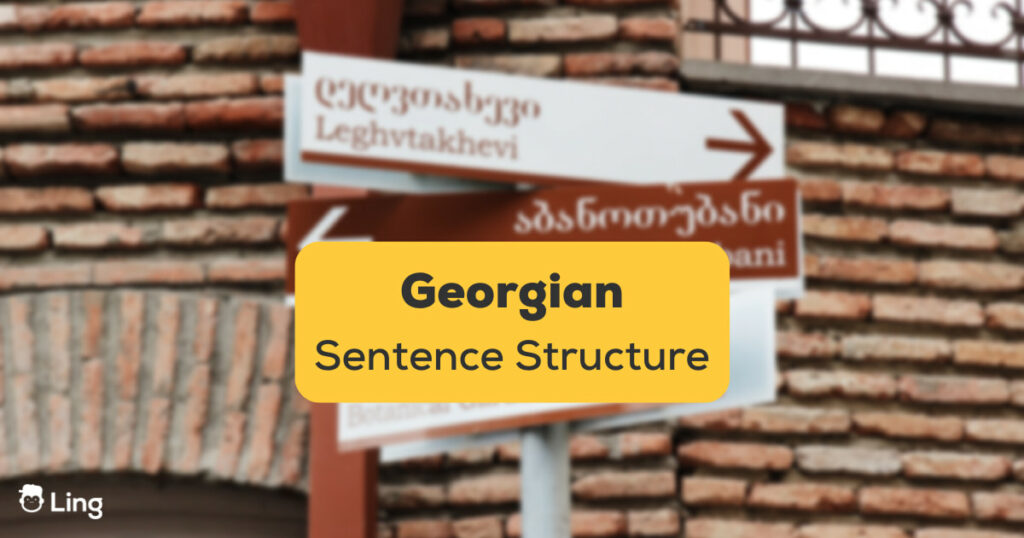Did you know that Georgian is the oldest surviving literary text still used widely today? If that excites you, then it’s best to learn about the basic Georgian sentence structure today! In today’s post, we’ll discuss the essential parts that make a complete Georgian sentence structure in the easiest way possible. If you’re up for that, then keep reading!
Georgian has been the official language of the country Georgia since 1629. I bet you might think an old language like this has undergone various sentence structure changes. Yet, it still retains the Kartvelian linguistic system and is even closer to the Kartilian dialect! It also didn’t change its writing system, so if you’re learning Georgian today, you’re lucky to speak an almost archaic language!
Many languages have different word orders according to their conjugation system, gender cases, and other grammar rules. Compared to other American, Asian, or European languages, Georgian can have a simple approach when it comes to sentence structures. Yet, many native speakers say it’s challenging to learn if you don’t know Russian or Farsi.
To get to the bottom of this, let’s go through the Georgian sentence structure with this comprehensive guide.
A Typical Georgian Sentence Structure
In learning a new language, it’s essential to go through all the aspects of the language (writing, speaking, reading, and listening) to daily conversations. To do this, learners of Georgian often use language apps or private tutors to teach them every nook and cranny of the language. Fortunately, you don’t need to look elsewhere to memorize the typical Georgian sentences! Why? Because it’s super easy!
It’s easy to learn the pattern of a simple sentence if it’s always in its active, present simple tense form. Before diving deep into examples and Georgian grammar rules, let’s first check what a Georgian sentence looks like:
- He is a writer./ ის არის მწერალი. / is aris mts’erali.
He here is the subject, is acts as the verb, and the writer is the object.
Similar to other languages, Georgian sentences can take different forms depending on the usage. It also has a case system, imperative forms, and negative sentences. You’ll also encounter transitive and intransitive verbs. You’ll also notice that the Georgian language does not have a specific grammatical gender in any of its sentences. However, you’ll know how the genitive case is used according to context clues.
Since Georgian has a unique culture of their own, there are instances in some pronoun arguments that have gender roles. However, similar to the Russian language, this language also uses plural pronouns for most of its sentences. In this case, modern Georgian sentences include gender-neutral personal pronouns or use a plural they (ისინი; isini) or a gender-neutral word like pilot პრინავი (p’rinavi).
Word Order In Georgian

Georgian word order is not very strict. However, one typical sentence structure is Subject-Verb-Object. Check out the example sentence below:
- They are playing a game./ ისინი თამაშობენ თამაშს/ isini tamashoben tamashs.
They are the subject, are playing is the verb, and a game is the object.
Similar to the sentence earlier, it is formed using the Subject-Verb-Object forms. But what do these terms mean?
The Subject is the main doer (acting) of the verb in the sentence. It’s usually a person, object, place, or thing (nouns). The Verb is what’s happening in the sentence. It usually has tenses (present, past, future) and irregular verbs or can be classified as a transitive or intransitive verb. The Object in a sentence is a bit tricky, even in English. You’ll need to determine to which the subject does the verb to.
On the other hand, you can also form a sentence using the Subject-Object-Verb with Georgian.
Let’s take a look at this sentence:
- His book was destroyed./ მისი წიგნი განადგურდა. /misi ts’igni ganadgurda.
His is the subject, book is the object, and was destroyed is the verb.
As you’ve seen in this example, Georgian sentences could also follow an active and passive voice. There are also singular and plural forms that may change how the sentences are formed.
What are the other instances that the Georgian sentence structure is different? Let’s look at the Georgian language’s various sentence features.
Subject + Verb (S + V)
What are verbs? They are the action words that the subject does in a sentence. Often, verbs are between the subject (noun) and the object (another noun, adjective, verb, etc.). A verb stem may also become the grammatical subject according to how it is written. It may also denote linking verbs or a verb + ing.
In Georgian verbs, you will still need to conjugate but only according to four classes: transitive, intransitive, medial, and indirect verbs. It doesn’t contain too many gender conjugation rules or pronoun conjugation, unlike French, Spanish, or Italian.
The word order for an S + V structure is usually Subject-Verb, Subject-Object-Verb (SOV), or Subject Verb Object (SVO) pattern.
Here are more examples to observe:
| English | Georgian | Romanization |
| I ate | მე ვჭამე | me vch’ame |
| I sang to him | მე მას ვუმღერე | me mas vumghere |
| They went to school | სკოლაში წავიდნენ | sk’olashi ts’avidnen |
Negation Sentences
In the Georgian grammar rules, Georgian also consists of negative imperatives or negation sentences that denote disapproval or having an opposite outcome. Negation is formed in simple sentences by placing “ar”, – ver before the main conjugative verb. Check out these sentences:
| English | Georgian | Romanization |
| I don’t speak Georgian | მე არ ვობს ქართული | me ar vobs kartuli |
| Do not enter this room | არ შეხვიდეთ ამ ოთახში | ar shekhvidet am otakhshi |
| I am not going to the festival | ფესტივალზე არ მივდივარ | pest’ivalze ar mivdivar |
| He is not in there | ის იქ არ არის | is ik ar aris |
| Don’t leave me | არ დამტოვო | ar damt’ovo |
Question Words/Sentences
Do you know the question words in English? These are how, why, where, when, which, and what. Similarly, Georgian has interrogative pronouns to help construct these question words better. Don’t forget that these question words may also have verb conjugations or different pronouns according to gender. Moreover, question words in Georgian are usually in the transitive verb format.
| English | Georgian | Romanization |
| Why did he use the car? | რატომ გამოიყენა მან მანქანა? | rat’om gamoiq’ena man mankana? |
| What was his excuse? | რა იყო მისი საბაბი? | ra iq’o misi sababi? |
| How can you learn Georgian fast? | როგორ შეიძლება სწრაფად ისწავლო ქართული? | rogor sheidzleba sts’rapad ists’avlo kartuli? |
Check out our guide on asking Georgian questions to get close to your Georgian friend.
Word Orders For The Grammatical Case System

In the English language, a grammatical case refers to a group of nouns, adverbs, numerals, adjectives, or pronouns that fulfills the function of those groups of words in a sentence. Words may transform by adding a prefix, a suffix, or changing words.
There are seven cases that you’ll commonly see and use in Georgian sentences. It comprises the cases of adverbial, dative, genitive, nominative, vocative, instrumental, and ergative (motxrobiti). What are these seven cases? Let’s start learning!
Adverbial Case
A Georgian standard sentence structure features adverbs, verbs stem, nouns, and pronouns. No matter which different languages you study, you’ll always find adverbial phrases that function similarly to question words with modifiers like which, what, and where of what’s happening. Unlike question words, adverbial case talks about the narrative, describing the situation. Adverbs modify the main clause of that sentence.
In Georgian, the adverbial case marker is -ად (-ad).
The adverbial case is found in the word order, such as the following:
- He was appointed as the Prime Minister. / ის პრემიერ-მინისტრად დაინიშნა. / is p’remier-minist’rad dainishna.
Dative Case
What is a dative case? It is frequently used as an expression of place and time. It is also mainly used for subjects in indirect verbs and transitive verbs. It shows the person, place, or thing that benefits from the action words (verbs), which is the indirect object.
In Georgian, the dative case marker is -ს (-s)
The word order for a dative case looks like this:
- He wrote the recipe for her. / მან დაწერა რეცეპტი მისთვის / man dats’era retsep’t’i mistvis.
Nominative Case
For the nominative case, it uses the marker -ი (-i).
The nominative case is usually the common sentence pattern in different languages. It talks about the nouns or pronouns that are the sentence’s subject. However, even a direct object can become a subject in Georgian, given that it is a personal pronoun.
For example, the word order for the nominative case looks like this:
- That pencil belongs to him. / რომ ფანქარი მას ეკუთვნის. / rom pankari mas ek’utvnis
That pencil is the subject but also the direct object of this sentence. Him is a pronoun that may look like the main subject of this sentence. Instead, it works as an indirect object. You’ll notice that this sentence is also in the passive voice.
Vocative Case
A vocative case is to show which the subject is talking to directly. Most of its modifiers are adjectives, nouns, participles, and determiners. It also addressed the second-person singular or plural words.
In Georgian, the vocative case marker is -ო (-o)
The word order for the vocative case is:
- Handsome man / სიმპათიურო მამაკაცო / simp’atiuro mamak’atso
Instrumental Case
The instrumental case corresponds to the way the subject uses an object. So, most words in this word order are usually adverbs, adjectives, or nouns.
In Georgian, the instrumental case marker is -ით (-it)
Let’s take a look at how it is used:
- He is cutting the paper with scissors. / ქაღალდს მაკრატლით ჭრის / kaghalds mak’rat’lit ch’ris
Ergative (Motxrobiti) case:
In Georgian, the ergative case marker is -მა (-ma)
The ergative case in Georgian is special. It has split ergativity, which means that Georgian can both have ergative-absolute and marked ergative sentences. Most of the time, the ergative case can also be the narrative case of Georgian. It can also have a transitive verb format as the main pattern.
What does a transitive verb grammar pattern look like? N+V+N or N+V for past and present tense. N is for Noun, and V stands for the verb.
- The chef cooks the meat. / შეფ-მზარეული ამზადებს ხორცს / shep-mzareuli amzadebs khortss.
However, the intransitive verb grammar pattern is just N+V which you can write as:
- The student goes / სტუდენტი მიდის / st’udent’i midis
- The fire burned / ცეცხლი დაიწვა / tsetskhli daits’va
So that’s it!
We hope you’ve learned the basics of Georgian sentence structure. Although it’s understandable that you still have questions about this language. Don’t worry; we’ve already made several topics about Georgian grammar that you’ll enjoy, such as telling time in Georgian. On the other hand, if you’re a serious learner and want to expand your Georgian vocabulary, look at these basic Georgian words. You’ll become fluent in Georgian in no time!
Practice Your Georgian Sentences With Ling

Your journey in making Georgian your second language is still ongoing! A historic literary language such as Georgian will not only make you appreciate different Georgian grammar rules but also take on the challenge of understanding the concept behind their word root.
Want to know more European languages? Why not try Tagalog or Albanian? There are 60+ languages that you can find in the Ling app. And it doesn’t stop at learning vocabulary only. You’ll also know how to speak like a true native.
Learning Georgian grammar, vocabulary, and even travel phrases is fun with a handy resource like the Ling app. So what are you waiting for? Download the Ling app on the Play Store or App Store and join the fun now!



































































